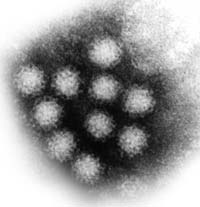| The
Bug |
Norwalk
and Noroviruses - General Overview
Norwalk virus was first identified as the cause of a primary
school outbreak of vomiting/diarrhea in Norwalk, Ohio in the
early 1970’s. Since that outbreak, similar viruses have
been identified as the cause of outbreaks in Montgomery County,
Hawaii, Snow Mountain, Taunton, Toronto, and during the Desert
Storm campaign. Like Norwalk virus, these viruses have been
named after their geographic setting and share similar symptoms
and epidemiology. This group of viruses is collectively referred
to as Noroviruses. Noroviruses cause viral gastroenteritis
predominately during the winter in temperate climates.
Norovirus outbreaks may be the
result of poorly controlled water management, contamination
of food (particularly during preparation for large numbers
of people), and/or amplification of person to person spread.
Institutional outbreaks in hospitals, daycare facilities,
nursing homes, schools, and hostels are common. On average,
there are 40 institutional outbreaks in Toronto every year.
 |
The Noroviruses
has an incubation period of 12 to 48 hours. Illness is
characterized by the sudden onset of vomiting and/or diarrhea.
Other symptoms commonly reported are nausea, abdominal
cramps, fever, headache, chills and muscle aches. Symptoms
usually last 1 to 3 days, while 2-3% of cases experience
symptoms for longer. |
|